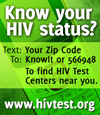Prevention and Education
Basic Information
HIV and AIDS are life threatening conditions. There is no cure yet for HIV/AIDS. The transmission of HIV occurs through three well documented means: 1) having sex (anal, vaginal, or oral) with someone infected with HIV; 2) sharing needles and syringes with someone infected with HIV; and 3) being exposed (fetus or infant) to HIV before or during birth or through breast feeding. HIV transmission can be prevented through avoiding behaviors that expose someone to the means of transmission and by taking preventive measures if identified risk behaviors occur.
To protect yourself, do not inject illicit drugs and remember these ABCs:
- A=Abstinence
- B=Be Faithful
- C=Condoms
HIV is not transmitted through day-to-day activities such as shaking hands, hugging, or a casual kiss. You cannot become infected from a toilet seat, drinking fountain, doorknob, dishes, drinking glasses, food, or pets. You also cannot get HIV from mosquitoes.
For more information about HIV transmission, please visit the Basic Information section about HIV/AIDS from the Centers for Disease Control and Prevention.
Basic Resources
HIV/AIDS Prevention (Centers for Disease Control and Prevention)
The Centers for Disease Control and Prevention (CDC) provides leadership in helping control the HIV/AIDS epidemic by working with community, state, national, and international partners in surveillance, research, and prevention and evaluation activities. This provides a variety of prevention information including basic information, fact sheets, brochures, and questions and answers. En español
HIV and Its Transmission (Centers for Disease Control and Prevention)
Research has revealed a great deal of valuable medical, scientific, and public health information about the human immunodeficiency virus (HIV) and acquired immunodeficiency syndrome (AIDS). The ways in which HIV can be transmitted have been clearly identified. Unfortunately, false information or statements that are not supported by scientific findings continue to be shared widely through the Internet or popular press. This fact sheet prepared by the Centers for Disease Control and Prevention (CDC) serves to correct a few misperceptions about HIV. En español
HIV and AIDS: Are You at Risk? (Centers for Disease Control and Prevention)
Provides basic information about HIV and AIDS, the behaviors that place people at risk for HIV, and preventive measures everyone can take to prevent HIV.





 Did you know that behaviors associated with drug abuse are among the main factors in the spread of HIV infection in the United States?
Did you know that behaviors associated with drug abuse are among the main factors in the spread of HIV infection in the United States?